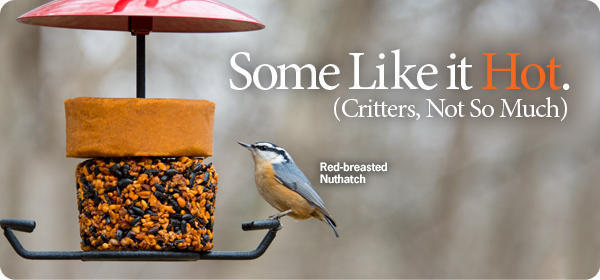Now That's Hot!!

Suffering through the dog days of summer, the last thing you probably want to hear more about is heat. But we’re going to talk about a different kind of heat, chili pepper heat.
We often have customers who look at some of our products in the store and ask, “who likes to eat the hot pepper food?” The answer, it’s not who likes it, but rather, who doesn’t.
If you’ve been visited by squirrels, raccoons, deer or opossums and wish they weren’t eating the food you meant for your birds to enjoy, then this article will be of interest to you. For the others who aren’t plagued by these unwanted visitors, you hopefully find the science and general knowledge interesting. Some of you may already be using squirrel proof feeders, baffles, cages and even bringing in your feeders at night to thwart these unwanted visitors. All of them can be highly effective strategies. But now you can consider an additional option of using a variety of bird foods which contain hot pepper. When you use hot pepper products, you won’t have to use cages, baffles, squirrel proof feeders or bring your feeders in at night because the critters learn that your bird food is not tasty to them and they will avoid it.
Two questions are always asked when considering this alternative strategy. First, do the birds not taste the hot pepper and second, doesn’t it hurt them? Science will help us to answer these questions.
A quick primer on taste might be helpful. We have a well-developed sense of taste which is partly from the benefit of having about 10,000 taste buds. Our taste buds contain taste receptors which sense 5 types of taste: salt, sweet, bitter, sour and savory or Umami. Songbirds, on the other hand, only have about 50 taste buds. So, birds do in fact taste their food. Studies have shown they can distinguish between, sweet, salt, brine, bitter, lipids (fats) and sugar concentrations.
While we say that something tastes spicy or hot, we don’t actually “taste” the heat from peppers. Rather, the heat from peppers is a perception of pain. Along with taste buds, we also have pain receptors in our tongue which are triggered by a protein in peppers called capsaicin. So, while we will taste the various flavors in our food, we experience the pain from capsaicin in spicy foods. And why we say, “that really burns.”
Our pain receptors for capsaicin and those of squirrels, raccoons etc. are similar; the pain receptors in birds are different. These pain receptors are like keyholes and capsaicin is like a key. In humans, the capsaicin key fits in the keyhole and “unlocks” the sensation of pain. In birds, however, the capsaicin “key” doesn’t fit their pain receptor and thus doesn’t unlock the sensation of pain. So, what “tastes” hot to us, or squirrels, raccoons, etc., doesn’t taste hot to the birds.
In fact, there are some theories that suggest that this could be a coevolution of birds and chilis in some regions of the world. Namely that since birds don’t “taste” the heat from capsaicin, they can eat the chilis and when they fly to other places and leave their droppings, they “plant” chili seeds to grow in new locations. So, the chili plants continue to propagate, and the birds get a source of food that mammals can’t eat. In fact, there are many varieties of peppers which are called bird peppers or bird’s eye peppers.
Many people have tried home-made solutions, but they can be challenged by pepper which is not hot enough or dry pepper powder and flakes which don’t adhere to the food or settle to the bottom or get washed off.
With the wide variety of commercially manufactured seeds, seed blends and suets which are available with hot pepper mixed in, it’s quite easy to try this alternative to deterring your unwanted visitors to your backyard feeders.

